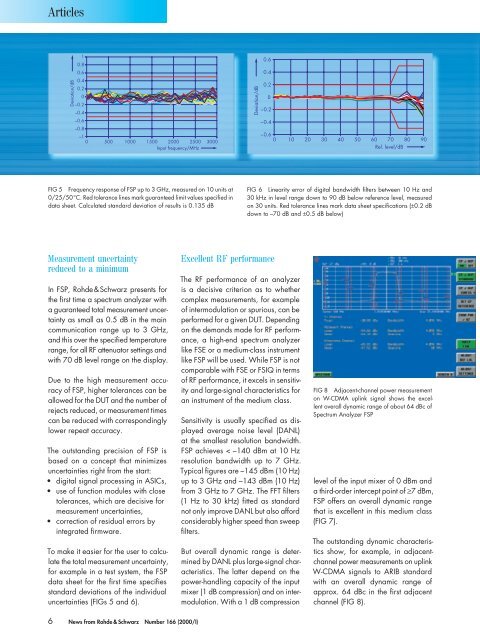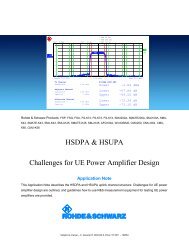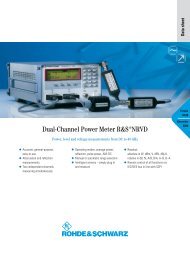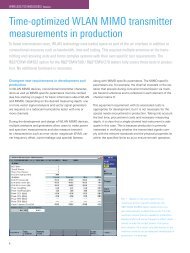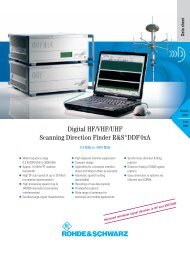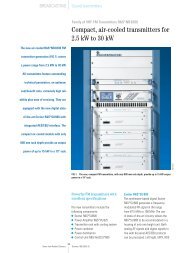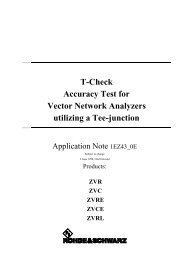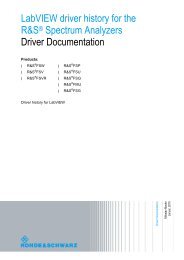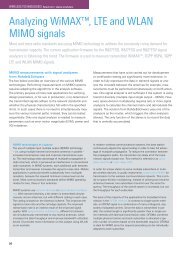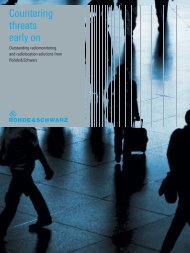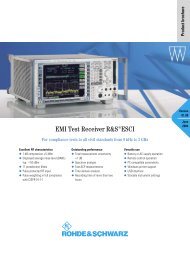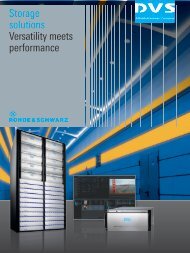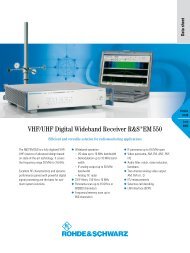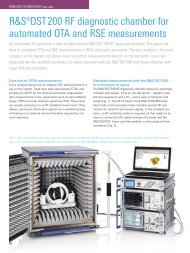English - Rohde & Schwarz
English - Rohde & Schwarz
English - Rohde & Schwarz
Create successful ePaper yourself
Turn your PDF publications into a flip-book with our unique Google optimized e-Paper software.
Articles<br />
Deviation/dB<br />
1<br />
0.8<br />
0.6<br />
0.4<br />
0.2<br />
0<br />
–0.2<br />
–0.4<br />
–0.6<br />
–0.8<br />
–1<br />
0 500 1000 1500 2000 2500 3000<br />
Input frequency/MHz<br />
FIG 5 Frequency response of FSP up to 3 GHz, measured on 10 units at<br />
0/25/50°C. Red tolerance lines mark guaranteed limit values specifi ed in<br />
data sheet. Calculated standard deviation of results is 0.135 dB<br />
Measurement uncertainty<br />
reduced to a minimum<br />
In FSP, <strong>Rohde</strong> & <strong>Schwarz</strong> presents for<br />
the fi rst time a spectrum analyzer with<br />
a guaranteed total measurement uncertainty<br />
as small as 0.5 dB in the main<br />
communication range up to 3 GHz,<br />
and this over the specifi ed temperature<br />
range, for all RF attenuator settings and<br />
with 70 dB level range on the display.<br />
Due to the high measurement accuracy<br />
of FSP, higher tolerances can be<br />
allowed for the DUT and the number of<br />
rejects reduced, or measurement times<br />
can be reduced with correspondingly<br />
lower repeat accuracy.<br />
The outstanding precision of FSP is<br />
based on a concept that minimizes<br />
uncertainties right from the start:<br />
• digital signal processing in ASICs,<br />
• use of function modules with close<br />
tolerances, which are decisive for<br />
measurement uncertainties,<br />
• correction of residual errors by<br />
integrated fi rmware.<br />
To make it easier for the user to calculate<br />
the total measurement uncertainty,<br />
for example in a test system, the FSP<br />
data sheet for the fi rst time specifi es<br />
standard deviations of the individual<br />
uncertainties (FIGs 5 and 6).<br />
6 News from <strong>Rohde</strong> & <strong>Schwarz</strong> Number 166 (2000/I)<br />
Deviation/dB<br />
0.6<br />
0.4<br />
0.2<br />
–0.2<br />
–0.4<br />
Excellent RF performance<br />
The RF performance of an analyzer<br />
is a decisive criterion as to whether<br />
complex measurements, for example<br />
of intermodulation or spurious, can be<br />
performed for a given DUT. Depending<br />
on the demands made for RF performance,<br />
a high-end spectrum analyzer<br />
like FSE or a medium-class instrument<br />
like FSP will be used. While FSP is not<br />
comparable with FSE or FSIQ in terms<br />
of RF performance, it excels in sensitivity<br />
and large-signal characteristics for<br />
an instrument of the medium class.<br />
Sensitivity is usually specifi ed as displayed<br />
average noise level (DANL)<br />
at the smallest resolution bandwidth.<br />
FSP achieves < –140 dBm at 10 Hz<br />
resolution bandwidth up to 7 GHz.<br />
Typical fi gures are –145 dBm (10 Hz)<br />
up to 3 GHz and –143 dBm (10 Hz)<br />
from 3 GHz to 7 GHz. The FFT fi lters<br />
(1 Hz to 30 kHz) fi tted as standard<br />
not only improve DANL but also afford<br />
considerably higher speed than sweep<br />
fi lters.<br />
But overall dynamic range is determined<br />
by DANL plus large-signal characteristics.<br />
The latter depend on the<br />
power-handling capacity of the input<br />
mixer (1 dB compression) and on intermodulation.<br />
With a 1 dB compression<br />
0<br />
–0.6<br />
0 10 20 30 40 50 60 70 80 90<br />
Rel. level/dB<br />
FIG 6 Linearity error of digital bandwidth fi lters between 10 Hz and<br />
30 kHz in level range down to 90 dB below reference level, measured<br />
on 30 units. Red tolerance lines mark data sheet specifi cations (±0.2 dB<br />
down to –70 dB and ±0.5 dB below)<br />
FIG 8 Adjacent-channel power measurement<br />
on W-CDMA uplink signal shows the excellent<br />
overall dynamic range of about 64 dBc of<br />
Spectrum Analyzer FSP<br />
level of the input mixer of 0 dBm and<br />
a third-order intercept point of ≥7 dBm,<br />
FSP offers an overall dynamic range<br />
that is excellent in this medium class<br />
(FIG 7).<br />
The outstanding dynamic characteristics<br />
show, for example, in adjacentchannel<br />
power measurements on uplink<br />
W-CDMA signals to ARIB standard<br />
with an overall dynamic range of<br />
approx. 64 dBc in the fi rst adjacent<br />
channel (FIG 8).


